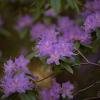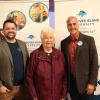August 7, 2010 - 9:15pm
Vancouver Island University’s Deep Bay Field Station goes beyond promoting sustainability for the shellfish aquaculture industry. The field station, with its distinctive clamshell shape, is also providing a model for green design and integrated regional development.
When it opens this fall, the field station will provide leading-edge teaching and research facilities as an extension of VIU’s Centre for Shellfish Research (CSR), said VIU President and Vice-Chancellor Ralph Nilson.
“The field station will also stimulate job creation and demonstrate the innovative ways that our coastal environment can be protected and enhanced through consultation, collaboration and creative partnerships,” Nilson said.
“The field station will be accessible to the public and visitors can get a sense of the wide variety of programs that VIU offers — whether they are tasting seafood dishes prepared by our culinary arts students, touring the grounds rehabilitated by our forestry and horticulture students or riding in the Chetlo, the durable craft built by students in our welding and aluminum boat building programs.”
VIU had initially considered a utilitarian facility but recognized the potential for the project to demonstrate environmentally friendly design features and building practices, said CSR director Don Tillapaugh.
“This is a unique opportunity to create a centre of excellence and innovation,” Tillapaugh said.
The field station has been designed and is being constructed to achieve a Leadership in Energy and Environmental Design (LEED®) Platinum rating. It represents the highest standard in the internationally recognized certification program, administered in this country by the Canada Green Building Council.
“We intend to demonstrate how we can minimize our environmental impact in the coastal zone,” said Field Station Manager Brian Kingzett. “That means reducing our use of freshwater, our use of energy and the amount of carbon that we produce. We’re also doing it in a rural environment which makes it quite unique.”
The 13,000 square foot structure sits on a three-hectare waterfront site in the scenic coastal community of Deep Bay between Qualicum Beach and Courtenay, known locally as Lighthouse Country. “We’re at the south end of Bayne’s Sound, the area of British Columbia where half of all the farmed shellfish are grown. This area is very important ecologically, environmentally and socially,” Kingzett said.
Cori Lynn Germiquet, President of the Vancouver Island Economic Alliance, praised VIU for taking “a holistic approach in the development of this project.”
“They have taken extreme care to ensure that the site is integrated into the environment and the local community. The field station is demonstrating leadership in promoting responsible sustainable development on Vancouver Island.”
There is a well-established tradition of field stations as educational and research tools for post-secondary institutions.
“What we’re doing is taking a terrestrial agricultural field station model and applying it in a very unique way to the marine environment. We have an on-land field station with seawater labs for research and shellfish hatchery work and marine environmental studies,” Kingzett said.
“We also have a working shellfish farm where we will develop new technologies such as the improved design of rafts used in the industry. And, we’re working on new species for aquaculture such as the native basket cockle (Clinocardium nuttallii).”
Students in VIU’s Culinary Institute of Vancouver Island will have access to a teaching kitchen at the field station to develop their skills in preparing seafood and other local foods and cater special events. There will also be opportunities for cooking classes open to the public.
The field station is using “state-of-shelf” green technologies that are readily available to the public. “We’re going to do ocean geothermal, use high-efficiency lighting and other electronic controls as well as passive systems and we’re going to do these things in ways that the field station itself will be a significant teaching tool for the university and the public. We hope to springboard what we’re doing into promoting more green development and really acting as a teaching tool for the community at large,” said Kingzett.
“There are aspects of everything that we are using that people might be able to use in their own new homes or their business projects, so we are trying to showcase that in the building. People who visit the field station will be able to say ‘oh, that’s how this works’ and see that the technology is accessible.”
The design team for the field station includes McFarland Marceau Architects Ltd., of Vancouver, which won a Royal Architecture Institute of Canada award for an Operations Centre built for Parks Canada on the Sidney waterfront. It was the first platinum LEED® certified building in Canada.
Structural engineering has been handled by Fast + Epp of Vancouver. One of that firm’s most high-profile projects is the Richmond Olympic Oval, site of the speed skating events at the 2010 Winter Games. The firm’s expertise is evident in the field station’s 14 gracefully curved beams that span the upper floor.
The theme of sustainability extends throughout the site. The building is made with a high-proportion of recycled materials, renewable resources such as wood and local materials. Solid wood floor panels have been produced from trees harvested in pine beetle-ravaged forests. Construction wood waste is being diverted from landfill by grinding it to mix as organics into topsoil. The topsoil will be used for all native and drought-resistant plants specified by a site plan by Nanaimo landscape architect Victoria Drakeford. Instead of paving, roadways will be covered with crushed oyster shells, a permeable surface that reduces rainwater runoff.
Michele Patterson, VIU’s Environment & Sustainability Manager, said the Deep Bay Field Station is an example of the kind of social and environmental innovation that showcases the university’s strong commitment to sustainability. “The field station will help to advance knowledge, understanding and research at VIU, and also support sustainable regional economies,” Patterson said. “We are committed to being a sustainability leader — in our operations, teaching, research and community engagement.”
Collaboration with community groups, Aboriginal representatives, the aquaculture industry and others is key to the success of the Deep Bay Field Station.
“The integrated approach focuses on how we as coastal communities develop in sustainable ways and transform from resource-based economies such as fishing and forestry to more knowledge-based economies such as what we’re doing with shellfish aquaculture,” Kingzett said. “The goal is to promote economic activity in a more environmentally friendly manner, in a more socially friendly manner and a more profitable manner.”
VIU’s Office of Development and Alumni is seeking additional partnerships with private funders, foundations and businesses for the field station. “We applaud and recognize the leadership of our provincial, federal and community funders for understanding the importance of the field station to the economic health of our coastal communities,” said Julie Keenan, Manager, Major Gifts & Legacies for the Office of Development and Alumni.
Barry Janyk, Chair of the Island Coastal Economic Trust, one of the major supporters of the field station, sees the project as a model for the innovative work that the Trust promotes.
“The Island and Coastal workplaces and educational institutions are in transition and a main aspect of our vision is to assist in the transformation to diversified, globally contributing and competitive, knowledge-based economies. The knowledge exchange from the Deep Bay Field Station to our region’s shellfish aquaculture industry is a sound example of a partnership that will support, broaden and invigorate the region’s economy.”
-30-
Note: Additional construction photographs are available on the Flickr site:
flickr.com/photos/viucsr/sets/72157624675267252/
For updates and the Deep Bay Field Station blog: viu.ca/deepbay
For more information, contact:
Don Tillapaugh,
Director, Centre for Shellfish Research,
Phone: 250-740-6113
Cell: 250-618-6056
Email: Don.Tillapaugh@viu.ca
Brian Kingzett,
Deep Bay Field Station Manager,
Centre for Shellfish Research,
Phone: 250-740-6399
Cell: 250-714-9077
Email: Brian.Kingzett@viu.ca
On the web: viu.ca/deepbay
Julie Keenan,
Manager, Major Gifts & Legacies,
VIU Office of Development and Alumni
Phone: 250-740-6602
Email: Julie.Keenan@viu.ca
Fact Sheets
Sustainable Design Principles
Principles established to guide the project have been established and include:
• Demonstrate best practices to raise public awareness of issues affecting coastal environmental health
• Protect the foreshore from negative impacts from human activity
• Protect and enhance riparian and species-at-risk habitat
• Protect and respect archaeological resources from development impact
• All planting to be indigenous species only
• Utilize natural resources of the site: Sun, Wind, Rain, Ocean
• Restore damaged ecosystems resulting from previous land tenure
• Safeguard the quality of ground, surface and marine water
Existing Site Master Plan and Site Infrastructure
The site master plan has been developed in direct response to these principles, and features a deeply integrated approach to the challenges of the steeply sloping site. Design strategies include:
• Restoration with local community groups of riparian and fisheries habitat in areas previously impacted
• Replanting the site with indigenous plants to establish and/or repair the many ecosystems found on site
• Sand and peat from building excavation activities are being mixed with chipped wood waste from construction to create topsoil onsite for landscaping and native species replanting
• Local, natural products are incorporated in construction plans such as the crushed oyster shell parking lot instead of non-porous paving materials
• Development of a complex integrated strategy to meet the challenges of the water cycle for domestic, waste, storm, and fire suppression through rain water harvesting and storage
• The aquifer underlying the site will be used for domestic (potable) water.
• On-site tertiary treatment of all water used on site. The tertiary biological treatment area will reduce the BOD, TSS and TN concentration to less than 10mg/L. The tertiary filtration and UV disinfection area will reduce colloidal material followed by UV disinfection to reduce fecal coliform bacteria to non-detected levels. The use of constructed wetlands will provide further polishing of effluent prior to release.
• Reduction of water use through recycling and rainwater harvesting. Rainwater will be harnessed and stored for use in low-flow water conserving faucets and dual-flush toilets thus minimizing the potable water used in the sanitary waste system.
• Integrated storm water management including the creation of ponds and manufactured wetlands
• An implementation strategy which includes the incorporation of VIU student input into the project where appropriate, training experiences and on going interpretative functions
• Reduction and recycling of waste materials from construction where possible
Building Passive Design Features
• Natural ventilation: The building is designed to take advantage of natural ventilation. Mechanical ventilation heat will be recovered through a rotary heat exchanger.
• Daylighting: The building’s occupied spaces are designed to be naturally lit, not requiring artificial lighting during daylight hours.
• Engineered wall assembly to minimize thermal heat loss.
• The building structure has been designed to utilize common grades of lumber and innovative composite beams as a structural deck system for the floor and roof assemblies. Wood has a much lower embodied energy content that steel.
• Sanitary Treatment: The on-site tertiary treatment is designed to set standards for local treatment of waste in coastal areas with critical requirements on clean seawater to support shellfish resources. This will involve tertiary on-site treatment as well as final polishing wetland.
• Water Recycling: Rainwater water will be collect and stored in a reservoir tank mounted at the upper end of the site. This system will charge a gravity powered fire suppression system (sprinklers)
• Limiting use of VOC’s (volatile organic compounds) during construction
Wood First
• The building design embraces a wood first policy. Notable components are 1) structural fir laminated beams have been used for the building skeleton,; 2) a solid wood sub-floor consists of a high percentage of pine beetle wood in solid wood slab construction, 3) interior finishes are largely Douglas fir, 4) Building Sheathing includes cedar panelling.
Energy Efficiency, Conservation and Clean Energy Systems
• Energy Performance Model developed
• Heat Recovery: A central air system will recover much of the energy in exhaust air and systems designed to recover heat from mechanical equipment and drain water will contribute to the low energy consumption
• Geo-Exchange Ocean Heating : A heat exchanger and heat pump system will be employed to extract heat energy from seawater pumped ashore for research activities to heat the building and supplement domestic hot water
• Wood fired biomass boiler as geothermal heat backup system using onsite wood.
• Hydronic radiant heat distribution coupled with displacement ventilation
• High efficiency lighting to reduce lighting loads
• Smart sensors monitor occupancy and daylighting to operate energy systems
• Building Commissioning: The building will be fully commissioned by an independent commissioner to ensure operating efficiency
Quantitative estimate on greenhouse gas emissions
During the design development process an energy analysis was conducted to determine the predicted energy efficiency. A reference building based on the requirements of Natural Resources Canada’s (former) Commercial Building Incentive Program (CBIP) was used to compare to various design options. The final design anticipates that GHG emissions are estimated to be 54.6 tonnes/year, a 15.5 tonnes/year (22 per cent) reduction compared to the baseline building design (70.1 tonnes/year). The current building design is expected to provide a decrease in annual electricity use by 44 MWh/year ($2700 annually, a reduction of more than 75 per cent).
Tags: In the Community






